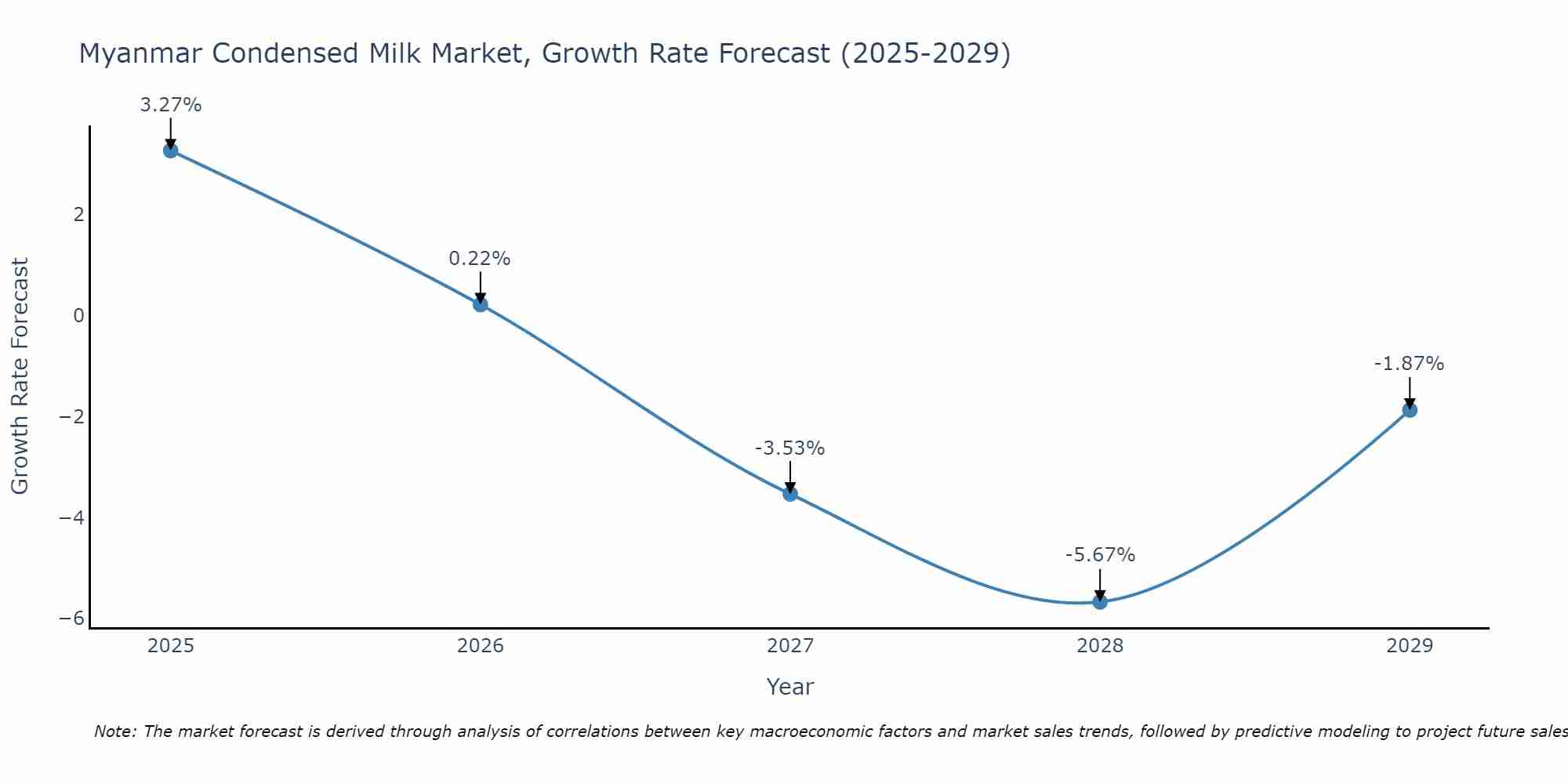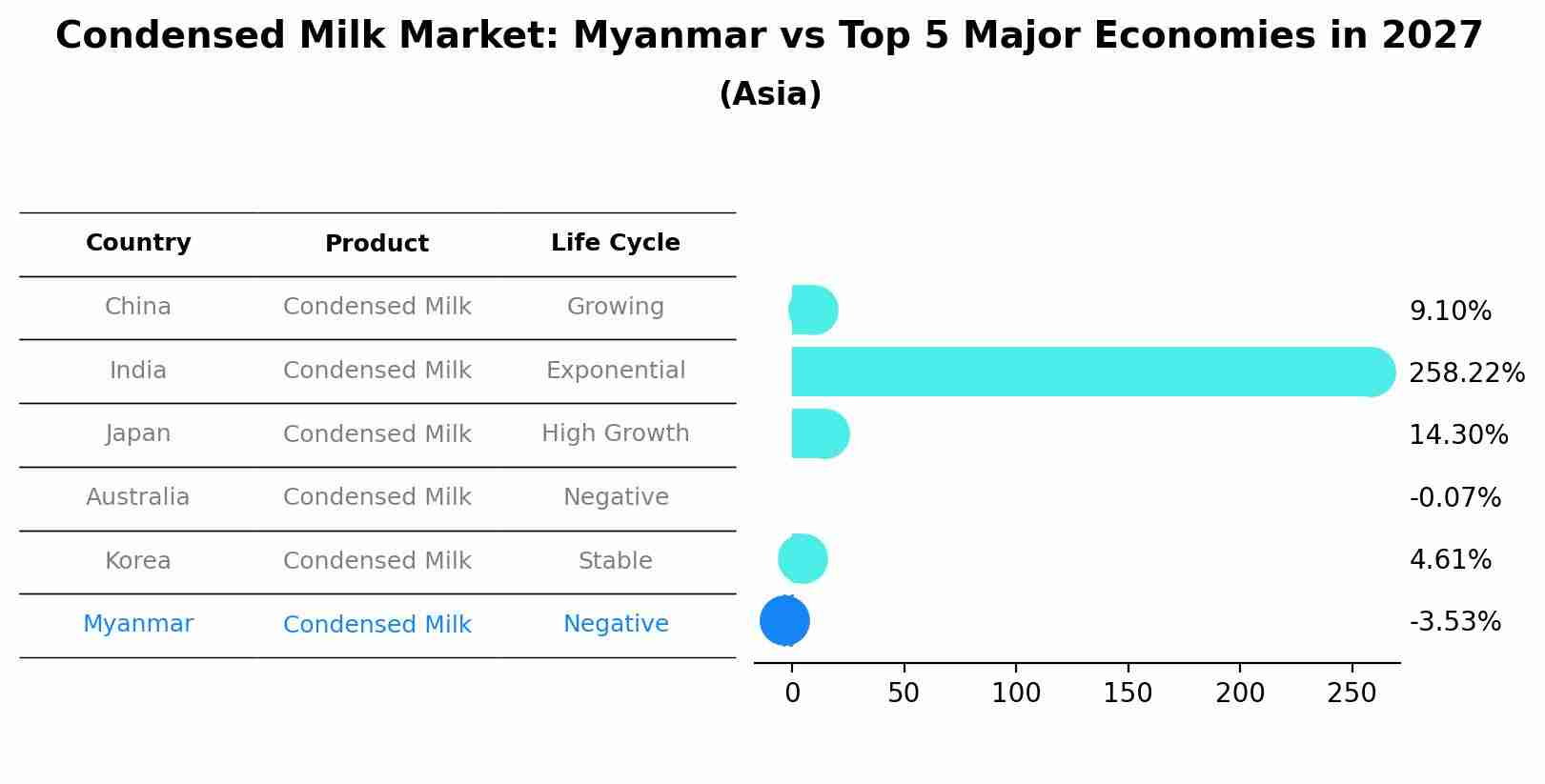Myanmar Condensed Milk Market (2025-2031) Outlook | Share, Size, Revenue, Trends, Companies, Forecast, Value, Growth, Industry & Analysis
| Product Code: ETC381094 | Publication Date: Aug 2022 | Updated Date: Apr 2025 | Product Type: Market Research Report | |
| Publisher: 6Wresearch | Author: Shubham Padhi | No. of Pages: 75 | No. of Figures: 35 | No. of Tables: 20 |
Myanmar Condensed Milk Market Size Growth Rate
The Myanmar Condensed Milk Market is projected to witness mixed growth rate patterns during 2025 to 2029. Starting high at 3.27% in 2025, the market steadily declines to -1.87% by 2029.

Condensed Milk Market: Myanmar vs Top 5 Major Economies in 2027 (Asia)
The Condensed Milk market in Myanmar is projected to grow at a negative growth rate of -3.53% by 2027, within the Asia region led by China, along with other countries like India, Japan, Australia and South Korea, collectively shaping a dynamic and evolving market environment driven by innovation and increasing adoption of emerging technologies.

Myanmar Condensed Milk Market Overview
The condensed milk market in Myanmar caters to the preferences of consumers for dairy products with extended shelf life and rich taste. Condensed milk is widely used in various culinary applications, including desserts, beverages, and sweet treats. As urbanization and disposable incomes rise in Myanmar, the demand for convenience foods and ingredients like condensed milk is increasing. Both domestic and international brands compete in this market, offering a range of products to meet consumer needs and preferences.
Drivers of the market
The condensed milk market in Myanmar is driven by the increasing consumption of dairy products and the growing preference for convenient and long-lasting food items. The rising disposable income and changing dietary habits contribute to the demand for condensed milk. Additionally, its widespread use in various culinary applications, including desserts and beverages, enhances market growth. The expansion of the retail sector and the availability of different product variants also play a crucial role in boosting the market.
Challenges of the market
In the Myanmar condensed milk market, challenges include supply chain inefficiencies and competition from fresh milk. The market relies heavily on imports, which are subject to high tariffs and logistical issues, leading to higher retail prices. Additionally, there is strong competition from locally produced fresh milk, which is often preferred by consumers for its perceived higher quality. The lack of robust cold chain infrastructure further complicates distribution, impacting product quality and shelf life. Moreover, marketing and consumer education about the uses and benefits of condensed milk are limited, affecting market penetration and growth.
Government Policy of the market
The dairy industry in Myanmar, including the condensed milk market, is supported by government policies that encourage local production and consumption of dairy products. Policies focus on improving the supply chain, from milk production to processing and distribution. Efforts to reduce import tariffs on dairy equipment and provide subsidies to local farmers help boost the production capacity and quality of condensed milk, aligning with nutritional and economic development goals.
Key Highlights of the Report:
- Myanmar Condensed Milk Market Outlook
- Market Size of Myanmar Condensed Milk Market, 2024
- Forecast of Myanmar Condensed Milk Market, 2031
- Historical Data and Forecast of Myanmar Condensed Milk Revenues & Volume for the Period 2021-2031
- Myanmar Condensed Milk Market Trend Evolution
- Myanmar Condensed Milk Market Drivers and Challenges
- Myanmar Condensed Milk Price Trends
- Myanmar Condensed Milk Porter's Five Forces
- Myanmar Condensed Milk Industry Life Cycle
- Historical Data and Forecast of Myanmar Condensed Milk Market Revenues & Volume By Product Type for the Period 2021-2031
- Historical Data and Forecast of Myanmar Condensed Milk Market Revenues & Volume By Dairy for the Period 2021-2031
- Historical Data and Forecast of Myanmar Condensed Milk Market Revenues & Volume By Non-Dairy for the Period 2021-2031
- Historical Data and Forecast of Myanmar Condensed Milk Market Revenues & Volume By Packaging Type for the Period 2021-2031
- Historical Data and Forecast of Myanmar Condensed Milk Market Revenues & Volume By Cans for the Period 2021-2031
- Historical Data and Forecast of Myanmar Condensed Milk Market Revenues & Volume By Tubes for the Period 2021-2031
- Historical Data and Forecast of Myanmar Condensed Milk Market Revenues & Volume By Bottles for the Period 2021-2031
- Historical Data and Forecast of Myanmar Condensed Milk Market Revenues & Volume By Distribution Channel for the Period 2021-2031
- Historical Data and Forecast of Myanmar Condensed Milk Market Revenues & Volume By Supermarkets and Hypermarkets for the Period 2021-2031
- Historical Data and Forecast of Myanmar Condensed Milk Market Revenues & Volume By Convenience Stores for the Period 2021-2031
- Historical Data and Forecast of Myanmar Condensed Milk Market Revenues & Volume By Specialty Stores for the Period 2021-2031
- Historical Data and Forecast of Myanmar Condensed Milk Market Revenues & Volume By Online Retails for the Period 2021-2031
- Historical Data and Forecast of Myanmar Condensed Milk Market Revenues & Volume By Others for the Period 2021-2031
- Myanmar Condensed Milk Import Export Trade Statistics
- Market Opportunity Assessment By Product Type
- Market Opportunity Assessment By Packaging Type
- Market Opportunity Assessment By Distribution Channel
- Myanmar Condensed Milk Top Companies Market Share
- Myanmar Condensed Milk Competitive Benchmarking By Technical and Operational Parameters
- Myanmar Condensed Milk Company Profiles
- Myanmar Condensed Milk Key Strategic Recommendations
Frequently Asked Questions About the Market Study (FAQs):
- Single User License$ 1,995
- Department License$ 2,400
- Site License$ 3,120
- Global License$ 3,795
Search
Thought Leadership and Analyst Meet
Our Clients
Related Reports
- Afghanistan Apparel Market (2026-2032) | Growth, Outlook, Industry, Segmentation, Forecast, Size, Companies, Trends, Value, Share, Analysis & Revenue
- Canada Oil and Gas Market (2026-2032) | Share, Segmentation, Value, Industry, Trends, Forecast, Analysis, Size & Revenue, Growth, Competitive Landscape, Outlook, Companies
- Germany Breakfast Food Market (2026-2032) | Industry, Share, Growth, Size, Companies, Value, Analysis, Revenue, Trends, Forecast & Outlook
- Australia Briquette Market (2025-2031) | Growth, Size, Revenue, Forecast, Analysis, Trends, Value, Share, Industry & Companies
- Vietnam System Integrator Market (2025-2031) | Size, Companies, Analysis, Industry, Value, Forecast, Growth, Trends, Revenue & Share
- ASEAN and Thailand Brain Health Supplements Market (2025-2031) | Strategy, Consumer Insights, Analysis, Investment Trends, Opportunities, Growth, Size, Share, Industry, Revenue, Segments, Value, Segmentation, Supply, Forecast, Restraints, Outlook, Competition, Drivers, Trends, Demand, Pricing Analysis, Competitive, Strategic Insights, Companies, Challenges
- ASEAN Bearings Market (2025-2031) | Strategy, Consumer Insights, Analysis, Investment Trends, Opportunities, Growth, Size, Share, Industry, Revenue, Segments, Value, Segmentation, Supply, Forecast, Restraints, Outlook, Competition, Drivers, Trends, Demand, Pricing Analysis, Competitive, Strategic Insights, Companies, Challenges
- Europe Flooring Market (2025-2031) | Outlook, Share, Industry, Trends, Forecast, Companies, Revenue, Size, Analysis, Growth & Value
- Saudi Arabia Manlift Market (2025-2031) | Outlook, Size, Growth, Trends, Companies, Industry, Revenue, Value, Share, Forecast & Analysis
- Uganda Excavator, Crane, and Wheel Loaders Market (2025-2031) | Strategy, Consumer Insights, Analysis, Investment Trends, Opportunities, Growth, Size, Share, Industry, Revenue, Segments, Value, Segmentation, Supply, Forecast, Restraints, Outlook, Competition, Drivers, Trends, Demand, Pricing Analysis, Competitive, Strategic Insights, Companies, Challenges
Industry Events and Analyst Meet
Whitepaper
- Middle East & Africa Commercial Security Market Click here to view more.
- Middle East & Africa Fire Safety Systems & Equipment Market Click here to view more.
- GCC Drone Market Click here to view more.
- Middle East Lighting Fixture Market Click here to view more.
- GCC Physical & Perimeter Security Market Click here to view more.
6WResearch In News
- Doha a strategic location for EV manufacturing hub: IPA Qatar
- Demand for luxury TVs surging in the GCC, says Samsung
- Empowering Growth: The Thriving Journey of Bangladesh’s Cable Industry
- Demand for luxury TVs surging in the GCC, says Samsung
- Video call with a traditional healer? Once unthinkable, it’s now common in South Africa
- Intelligent Buildings To Smooth GCC’s Path To Net Zero


















